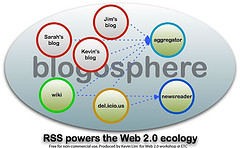In this first round of discussions about the readings, I saw several of you raise a number of interesting points and questions.
Shelby explains that she sees some parallels between the Brown essay and a book she recently read by James Surowecki called The Wisdom of Crowds. In the context of our discussion, she points to the potential for the internet to enable large-scale collaborations that before Web 2.0 were much more difficult.
Among the various concepts described by Brown, Melissa points to the concept of bricolage as one that has some of the most resonance with her because of the way in which it appears to coincide with what she sees some of her biology students do who … who design their own lecture outlines, study guides, and Facebook pages and share these with other students. In another part of her post, she describes a transition from resisting cellphone use in the classroom to welcoming it as she observed students use it to support their own learning needs in creative, unexpected ways – e.g., Some students make videos of themselves pointing out parts of anatomical models that they can watch again and again until they have the material mastered.
Due in part to the rapid proliferation of tools and information, Hannah urges teachers to see themselves also as learners, which can widen the opportunities for student input in the teaching and learning processes. Although it pushes against tradition, teachers don’t need to see themselves as the one with all the answers; students bring a rich array of experiences and skills to the classroom and these can be channeled into exciting new possibilities. We can see many examples of this through sites like Edutopia.
Marie echoes Hannah’s emphasis, however, she notes that this changing landscape also presents challenges for students – e.g., Shifting the idea of how people learn, especially students, is a hard task to accomplish in a nation that already has their philosophy set. She points out that a complicating factor in trying to create this more collaborative, project-based environment is high-stakes testing which seems to be designed for put more emphasis on individual modes and models of learning. With this in mind, she would like to see schools adopt greater openness in recognizing the different forms or types of learning that can occur in a learning environment compatible with the needs of an information-age economy – e.g., We would need to be okay viewing a classroom as a working, non-structured area where students are talking, researching, doing different projects, etc.
From another angle, Justin notes that while he prefers a learning approach that favors a guide on the side, he nevertheless concedes that it can be easier said than done. He further explains that a more facilitative approach encourages the student to take greater sense of ownership and direction in their learning, because the instructor is prompting the student through questions and authentic problem-solving scenarios rather than spelling everything out for them through didactic lectures.
Good work folks 🙂 I look forward to reading more!




You must be logged in to post a comment.